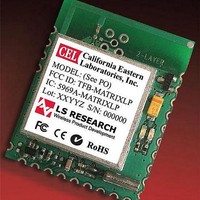ZMXM-400-1-B CEL, ZMXM-400-1-B Datasheet - Page 11

ZMXM-400-1-B
Manufacturer Part Number
ZMXM-400-1-B
Description
Zigbee / 802.15.4 Modules & Development Tools Matrix Zigbee 10mW 10MW Module
Manufacturer
CEL
Datasheet
1.ZMXM-400-KIT-2.pdf
(13 pages)
Specifications of ZMXM-400-1-B
Wireless Frequency
2405 MHz to 2480 MHz
Interface Type
UART
Operating Voltage
3.6 V
Output Power
100 mW
Antenna
PCB Trace
Operating Temperature Range
- 45 C to + 125 C
Lead Free Status / RoHS Status
Lead free / RoHS Compliant
PROCESSING (Continued)
Cooling Phase
A controlled cooling phase avoids unwanted metallurgical effects of the solder, and possible mechanical tensions in the
products. Controlled cooling helps achieve the brightest possible solder fillets with a good shape and low contact angle.
• Temperature fall rate: max 3ºC/sec
Pb-Free Soldering Paste
Use of “No Clean” soldering paste is strongly recommended, as it does not require cleaning after the soldering process.
The pastes listed in the examples below meet these criteria.
Soldering Paste: Indium 5.1 (Indium Corporation of America)
Alloy Specification: SAC305 - Sn Zinc 96.5%/Ag Silver 3.0%/Cu Copper 0.5%
Alloy Specification: SAC387 - Sn Zinc 95.5%/Ag Silver 3.8%/Cu Copper 0.7%
Melting Temperature: 217ºC
Soldering Paste: LFSOLDER TLF-206-93F (Tamura Kaken [UK] Ltd.)
Alloy Specification: Sn Zinc 95.5%/Ag Silver 3.9%/Cu Copper 0.6%
Melting Temperature: 216-221ºC
The final choice of the soldering paste depends on individual factory approved manufacturing procedures.
Stencil Thickness: 150 µm for host boards
Note:
Cleaning
In general, cleaning the populated modules is strongly discouraged. Residuals under the module cannot be easily removed
with any cleaning process.
•
•
•
The best approach is to consider using a “no clean” soldering paste and eliminate the post soldering cleaning step.
Cleaning with water can lead to capillary effects where water is absorbed into the gap between the host board and
the module. The combination of soldering flux residuals and encapsulated water could lead to short circuits between
neighboring pads. Water could also damage any stickers or labels.
Cleaning with alcohol or a similar organic solvent will likely flood soldering flux residuals into the two housings, which is
not accessible for post-washing inspection. The solvent could also damage any stickers or labels.
Ultrasonic cleaning could damage the module permanently.
The quality of the solder joints on the castellations (‘half vias’) where they contact the host board should meet
the appropriate IPC specification. See IPC-A-610-12.2.4.
ZMXM-400 Series










